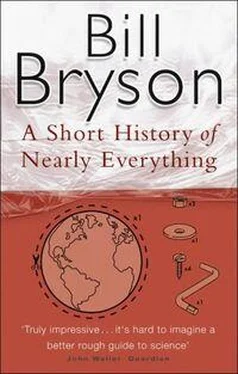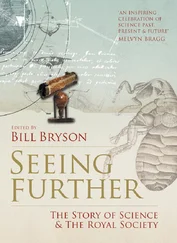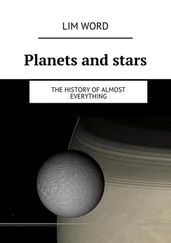Soon afterward the Astrophysical Journal published two articles: one by Penzias and Wilson describing their experience with the hiss, the other by Dicke’s team explaining its nature. Although Penzias and Wilson had not been looking for cosmic background radiation, didn’t know what it was when they had found it, and hadn’t described or interpreted its character in any paper, they received the 1978 Nobel Prize in physics. The Princeton researchers got only sympathy. According to Dennis Overbye in Lonely Hearts of the Cosmos , neither Penzias nor Wilson altogether understood the significance of what they had found until they read about it in the New York Times .
Incidentally, disturbance from cosmic background radiation is something we have all experienced. Tune your television to any channel it doesn’t receive, and about 1 percent of the dancing static you see is accounted for by this ancient remnant of the Big Bang. The next time you complain that there is nothing on, remember that you can always watch the birth of the universe.
Although everyone calls it the Big Bang, many books caution us not to think of it as an explosion in the conventional sense. It was, rather, a vast, sudden expansion on a whopping scale. So what caused it?
One notion is that perhaps the singularity was the relic of an earlier, collapsed universe-that we’re just one of an eternal cycle of expanding and collapsing universes, like the bladder on an oxygen machine. Others attribute the Big Bang to what they call “a false vacuum” or “a scalar field” or “vacuum energy”-some quality or thing, at any rate, that introduced a measure of instability into the nothingness that was. It seems impossible that you could get something from nothing, but the fact that once there was nothing and now there is a universe is evident proof that you can. It may be that our universe is merely part of many larger universes, some in different dimensions, and that Big Bangs are going on all the time all over the place. Or it may be that space and time had some other forms altogether before the Big Bang-forms too alien for us to imagine-and that the Big Bang represents some sort of transition phase, where the universe went from a form we can’t understand to one we almost can. “These are very close to religious questions,” Dr. Andrei Linde, a cosmologist at Stanford, told the New York Times in 2001.
The Big Bang theory isn’t about the bang itself but about what happened after the bang. Not long after, mind you. By doing a lot of math and watching carefully what goes on in particle accelerators, scientists believe they can look back to 10 -43seconds after the moment of creation, when the universe was still so small that you would have needed a microscope to find it. We mustn’t swoon over every extraordinary number that comes before us, but it is perhaps worth latching on to one from time to time just to be reminded of their ungraspable and amazing breadth. Thus 10 -43is 0.000000000000000000000 0000000000000000000001, or one 10 million trillion trillion trillionths of a second. [1]
Most of what we know, or believe we know, about the early moments of the universe is thanks to an idea called inflation theory first propounded in 1979 by a junior particle physicist, then at Stanford, now at MIT, named Alan Guth. He was thirty-two years old and, by his own admission, had never done anything much before. He would probably never have had his great theory except that he happened to attend a lecture on the Big Bang given by none other than Robert Dicke. The lecture inspired Guth to take an interest in cosmology, and in particular in the birth of the universe.
The eventual result was the inflation theory, which holds that a fraction of a moment after the dawn of creation, the universe underwent a sudden dramatic expansion. It inflated-in effect ran away with itself, doubling in size every 10 -34seconds. The whole episode may have lasted no more than 10 -30seconds-that’s one million million million million millionths of a second-but it changed the universe from something you could hold in your hand to something at least 10,000,000,000,000,000,000,000,000 times bigger. Inflation theory explains the ripples and eddies that make our universe possible. Without it, there would be no clumps of matter and thus no stars, just drifting gas and everlasting darkness.
According to Guth’s theory, at one ten-millionth of a trillionth of a trillionth of a trillionth of a second, gravity emerged. After another ludicrously brief interval it was joined by electromagnetism and the strong and weak nuclear forces-the stuff of physics. These were joined an instant later by swarms of elementary particles-the stuff of stuff. From nothing at all, suddenly there were swarms of photons, protons, electrons, neutrons, and much else-between 10 79and 10 89of each, according to the standard Big Bang theory.
Such quantities are of course ungraspable. It is enough to know that in a single cracking instant we were endowed with a universe that was vast-at least a hundred billion light-years across, according to the theory, but possibly any size up to infinite-and perfectly arrayed for the creation of stars, galaxies, and other complex systems.
What is extraordinary from our point of view is how well it turned out for us. If the universe had formed just a tiny bit differently-if gravity were fractionally stronger or weaker, if the expansion had proceeded just a little more slowly or swiftly-then there might never have been stable elements to make you and me and the ground we stand on. Had gravity been a trifle stronger, the universe itself might have collapsed like a badly erected tent, without precisely the right values to give it the right dimensions and density and component parts. Had it been weaker, however, nothing would have coalesced. The universe would have remained forever a dull, scattered void.
This is one reason that some experts believe there may have been many other big bangs, perhaps trillions and trillions of them, spread through the mighty span of eternity, and that the reason we exist in this particular one is that this is one we could exist in. As Edward P. Tryon of Columbia University once put it: “In answer to the question of why it happened, I offer the modest proposal that our Universe is simply one of those things which happen from time to time.” To which adds Guth: “Although the creation of a universe might be very unlikely, Tryon emphasized that no one had counted the failed attempts.”
Martin Rees, Britain’s astronomer royal, believes that there are many universes, possibly an infinite number, each with different attributes, in different combinations, and that we simply live in one that combines things in the way that allows us to exist. He makes an analogy with a very large clothing store: “If there is a large stock of clothing, you’re not surprised to find a suit that fits. If there are many universes, each governed by a differing set of numbers, there will be one where there is a particular set of numbers suitable to life. We are in that one.”
Rees maintains that six numbers in particular govern our universe, and that if any of these values were changed even very slightly things could not be as they are. For example, for the universe to exist as it does requires that hydrogen be converted to helium in a precise but comparatively stately manner-specifically, in a way that converts seven one-thousandths of its mass to energy. Lower that value very slightly-from 0.007 percent to 0.006 percent, say-and no transformation could take place: the universe would consist of hydrogen and nothing else. Raise the value very slightly-to 0.008 percent-and bonding would be so wildly prolific that the hydrogen would long since have been exhausted. In either case, with the slightest tweaking of the numbers the universe as we know and need it would not be here.
Читать дальше












